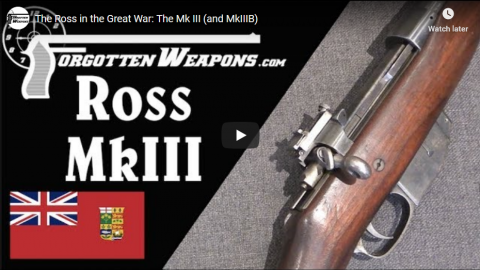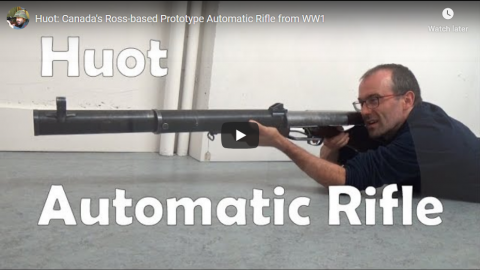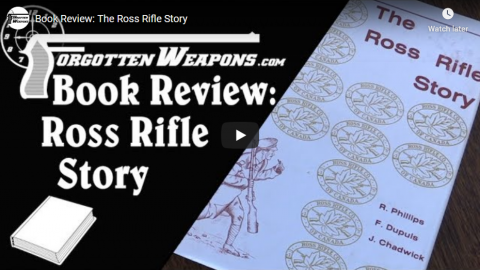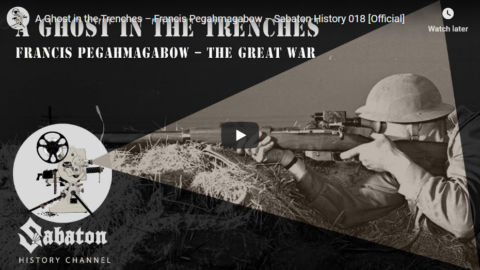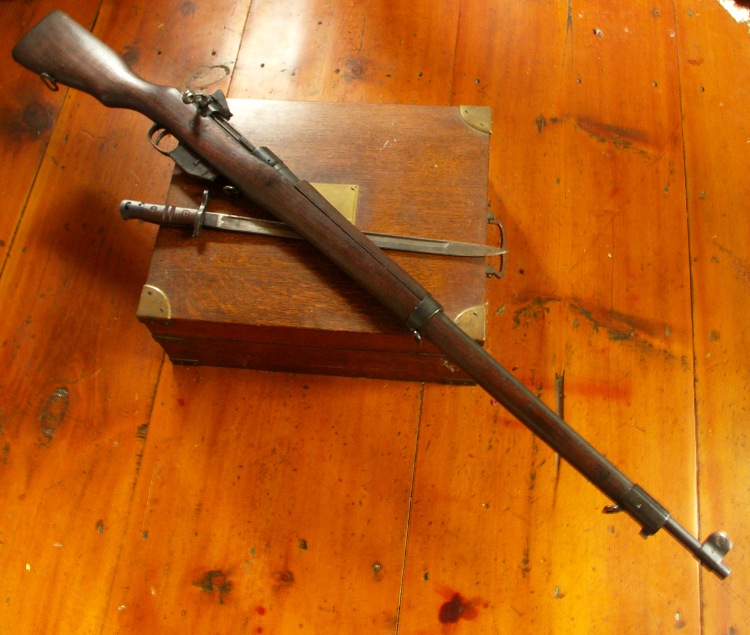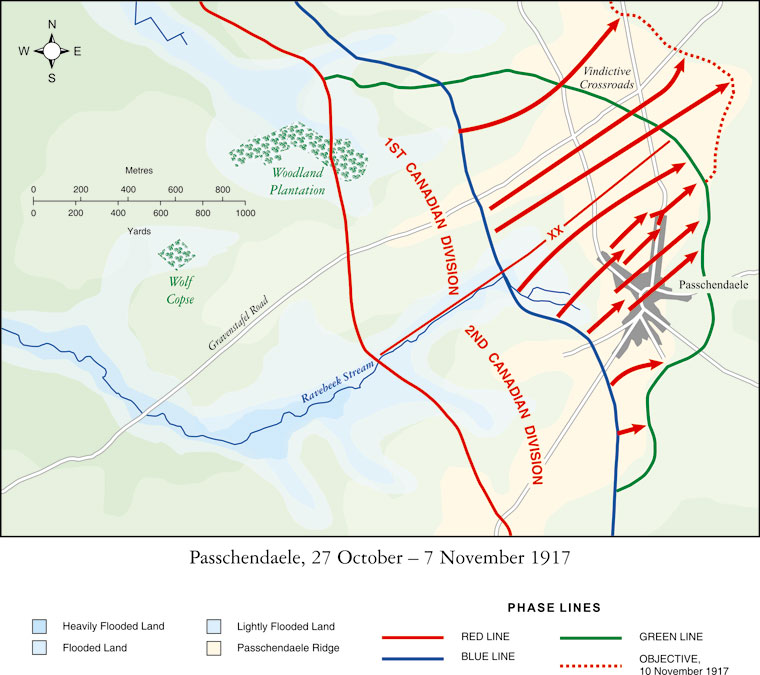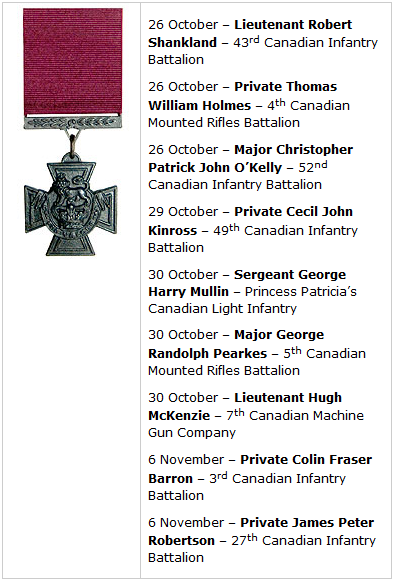Forgotten Weapons
Published 1 Nov 2019http://www.patreon.com/ForgottenWeapons
Cool Forgotten Weapons merch! http://shop.bbtv.com/collections/forg…
While the MkII (1905) iteration of the Ross rifle had resolved most of the major mechanical problems from the MkI, it retained a number of characteristics that the Canadian (and British) military was not fond of. In particular, it was not suited to the use of stripper clips. Starting with experimentation on sporting rifles, Ross substantially redesigned the action for the final 1910 pattern – aka the MkIII.
The MkIII used a rotating bolt as before, but with six locking lugs in two rows of three, instead of two large lugs as the MkI and II. The magazine was replaced by a conventional single-stack design, with a stripper clip guide built into the receiver, and with a nicely adjustable rear aperture sight. This would be the model to equip the Canadian infantry who went to Europe to fight in 1914 and 1915 – and it is there that a new set of problems would begin to plague the Ross.
In keeping with its sporting legacy and reputation for outstanding accuracy, the MkIII Ross was made with a rather tight chamber, optimized for the excellent-quality Canadian production .303 ammunition. Britain had been forced to massively increase ammunition supply as the war lengthened, and British standards had widened to accept ammunition that was really of rather questionable quality. The SMLE rifles used by British forces had chambers made to accommodate this, but the Rosses did not. Canadian ammunition was supposed to follow the Canadian troops, but it was usually diverted to other services because of its high quality, and the Canadians left with ammo that was difficult to chamber or extract in the Ross.
This led to men having to beat open rifle bolts, which led to damage to locking lugs, in a viscous circle of escalating problems. By the time of the German gas attack at Ypres, Canadians were ditching their Rosses for Lee Enfields by the thousands, despite specific orders to the contrary. General Haig finally had enough of the issues, and ordered the Ross removed from combat in 1916, to be replaced by the SMLE (which was finally available in sufficient numbers to arm the Canadian troops).
Contact:
Forgotten Weapons
6281 N. Oracle #36270
Tucson, AZ 85704
November 4, 2019
The Ross in the Great War: The Mk III (and MkIIIB)
September 20, 2019
Huot: Canada’s Ross-based Prototype Automatic Rifle from WW1
Bloke on the Range
Published on 18 Jul 2019Patreon: https://www.patreon.com/BlokeOnTheRange
Due to a shortage of Lewis guns and a glut of withdrawn Ross Mk.III rifles once the Canadian Expeditionary Force had been completely re-equipped with Lee-Enfield SMLE rifles, Monsieur Huot proposed to modify Ross rifles into an automatic rifle / light machine gun (LMG) configuration.
5 of these are known to exist, this is number 2, and is in the Seaforth Highlanders of Canada museum in Vancouver: https://www.seaforthhighlanders.ca/ho…
Many thanks to them for the opportunity to handle and film this exceptionally rare piece! Please give them a visit!
September 12, 2019
Book Review: The Ross Rifle Story
Forgotten Weapons
Published on 8 Sep 2019http://www.patreon.com/ForgottenWeapons
Cool Forgotten Weapons merch! http://shop.bbtv.com/collections/forg…
The Ross Rifle Story is the Bible of Ross rifle collecting — it is the only substantial reference work on the subject and it has a tremendous amount of information about the development of the Ross. However, it is also one of the worst-edited firearms reference books I am aware of. It has a second Table of Contents on page 85 — need I say more than that?
Well, I will. The photographs are black and white and often too dark or too light. Beyond it really being two separate manuscripts printed back to back, the organization is really lacking. Finding information in the book is sometimes very difficult, as the subject matter jumps around a lot. The story of the Ross — especially separating the civilian and military development — is a pretty complicated one, and even a well-edited book on the subject might be a bit difficult to parse. This book is really bad at times.
But for all that, it does have the information (with only a few errors), and it’s the only book that does. If you are interested in the Ross, this is a must-have book despite its problems.
A second printing was run in 2002, and not much effort was put into marketing it. Despite the online prices all being $300+, the seller still has a couple dozen copies remaining as of this writing. To order one (for $100 plus shipping, via PayPal) email him at ross.rifle.story@sympatico.ca .
Contact:
Forgotten Weapons
6281 N. Oracle #36270
Tucson, AZ 85704
June 7, 2019
“A Ghost in the Trenches” – Francis Pegahmagabow – Sabaton History 018 [Official]
Sabaton History
Published on 6 Jun 2019As a ghost he roamed the trenches, effectively taking out his enemies one by one. He was the deadliest sniper of The Great War, with over 300 confirmed kills on his name. He is Canadian soldier Francis Pegahmagabow, born in an indigenous First Nations family, and the The Sabaton Song “A Ghost in the Trenches” is about his life and adventures.
Support Sabaton History on Patreon (and possibly get a History Channel special edition): https://www.patreon.com/sabatonhistory
Pre-order The Great War here: https://www.sabaton.net/pre-order-of-…
Check out the trailer for Sabaton’s new album The Great War right here: https://www.youtube.com/watch?v=HCZP1…
Watch more videos on the Sabaton YouTube channel: https://www.youtube.com/user/Sabaton?…
Listen to Sabaton on Spotify: http://smarturl.it/SabatonSpotify
Official Sabaton Merchandise Shop: http://bit.ly/SabatonOfficialShopHosted by: Indy Neidell
Written by: Markus Linke and Indy Neidell
Directed by: Astrid Deinhard and Wieke Kapteijns
Produced by: Pär Sundström, Astrid Deinhard and Spartacus Olsson
Creative Producer: Joram Appel
Executive Producers: Pär Sundström, Joakim Broden, Tomas Sunmo, Indy Neidell, Astrid Deinhard, and Spartacus Olsson
Maps by: Eastory
Edited by: Iryna Dulka
Sound Editing by: Marek KaminskiArchive by: Reuters/Screenocean https://www.screenocean.com
Music by Sabaton.Sources:
– IWM: Q 454, Q 17730, Q 50690, IWM 255, IWM 778, Q 17780, Q 745, IWM 466, IWM 208, Q 53538, E(AUS) 1497, E (AUS) 4677, E(AUS) 2078, Q 70213, Q 5977, Q 108213, Q 50553, Q 53637, Q 2638, Q 65444, Q 11668, Q 79508, Q 23706, Q 88121, Q 50638, IWM 207, Q 4135, Q 80267, Q 29027
– National Library of Scotland (NLS)
– Library and Archives Canada: Canadians advancing east of Arras.
– Auckland War Memorial Museum: AM 2016.26.1-3
– Canadian War Museum: George Metcalf Archival Collection, CWM 19940003-459, CWM 19920085-006, CWM 19920085-595, CWM 19920085-018, CWM 19940003-370, CWM 20040035-006An OnLion Entertainment GmbH and Raging Beaver Publishing AB co-Production.
© Raging Beaver Publishing AB, 2019 – all rights reserved.
From the comments:
Sabaton History
1 day ago
Many of you have been analysing the tracklist for the upcoming Sabaton Album The Great War. While the subjects of some of the songs are quite easy to guess, the exact topic of “A Ghost in the Trenches” was a mystery for many – although some did predict it correctly. The song is about the Canadian (and indigenous First Nations) soldier Francis Pegahmagabow, the deadliest sniper of the First World War. Indy – having researched and hosted the The Great War YouTube channel for the duration of the war, knows as much as there is to know about the subject, and is the most suitable person to tell you the story behind the song.Enjoy and Cheers!
December 2, 2018
Canada’s initial WW1 infantry weapon, the Ross rifle
During the Boer War, the British were busy producing Lee-Enfield rifles for the British army and didn’t have enough extra manufacturing capacity to fulfill a modest Canadian order. The government of the day took this opportunity to try to find a distinctly Canadian weapon to equip the (tiny) Canadian militia. They ended up purchasing the Ross rifle, which is what the men of the Canadian Corps took into the field during the First World War. It didn’t go well, as the highly accurate Ross was not well-suited to the rough-and-tumble life of an infantry weapon in the trenches of Flanders. The mechanism was prone to jamming in muddy conditions and did not work well with low-quality ammunition. It became a national scandal, and eventually most of the Ross rifles were replaced with British Lee-Enfields, except for the sniper weapons (where the Ross was much better suited to the needs of the job). The National Interest has the story:
Tested head to head with the Lee-Enfield Mark I, the Ross did well in some of the trials but came up short in other crucial ones, such as the endurance test. Some 1,000 rounds were fired through each rifle and, while the Lee-Enfield functioned well, the Ross repeatedly jammed. After the 300th round, the heat of firing melted away the foresight, which was fastened with common solder. Ross explained that prior tests had been conducted with ammunition of American and Austrian manufacture and that “the standard called for in the manufacture of British .303 cartridges is not of the same precision and quality of material hence greater limits have to be allowed.” His dubious explanation was accepted by the committee.
Already the enterprise was off on the wrong foot. Due to Borden’s choices, the investigative committee leaned in favor of the Ross. It was obvious that no accurate appraisal of anything can result from a biased investigative body. Hughes in particular championed the rifle, and his stubborn resistance to evidence that contradicted his opinions bordered on the irrational. To the end he would insist that the Ross was superior to the Lee-Enfield, even after thousands of Canadian soldiers had simply thrown theirs away on the battlefield.
If the weapon had flaws, so did the purchase contract. Under its terms, Ross was to provide 12,000 rifles during 1903 and 10,000 every year thereafter, with a 75 percent advance on all rifles ordered for the duration of the contract, which was not stipulated. The cost of the Ross was not to exceed that of a Lee-Enfield in Britain, yet the price set was $25, compared to $18.27 the War Office paid for a Lee-Enfield. The contract also stated that materials and machinery Ross needed to import to meet the manufacturing requirements were to be exempt from import taxes. Because there was no division outlined between military and sporting rifles, Ross could get all his imports duty-free, regardless of whether they were built for government contract or not. There was no guarantee Ross would provide more rifles in the event of a national emergency, only that he would provide 10,000 annually after the initial 12,000. There was also no mention in the contract of providing a bayonet.
[…]
The final verdict on the Ross was rendered in the vile ooze of mud, filth, and rotting corpses that characterized trench warfare during the Great War. From the first day of fighting, the frequent jamming of the Ross forced soldiers to strike the bolts with entrenching tools or boot heels to clear them. The problem was attributed to the British ammunition being used, which was slightly larger than Canadian- manufactured rounds, but a significant factor was faulty manufacturing that resulted in deformed firing chambers. Long and unwieldy, the Ross was also not well suited for use in narrow trenches. Soon, British Small Magazine Lee-Enfield rifles began appearing in the Canadian ranks, causing First Division commander Lt. Gen. E.A.H. Alderson to issue an order that his men were not permitted to be in possession of SMLE rifles. It was an order largely ignored.
If earlier investigations had repeatedly given the rifle a pass and rendered a skewed verdict, the Canadian soldiers in the trenches did not. In April 1915, after the bloody fight at the Second Battle of Ypres, Belgium, which also saw the first gas attacks of the war, 1,452 of the 5,000 surviving Canadian soldiers threw away their Ross rifles and picked up Lee-Enfields from British casualties. The verdict of the fighting soldier had been delivered. With confidence in the rifle badly damaged, British Commander in Chief Sir John French issued orders rearming the First Canadian Division with the SMLE.
Not all the reports from the line were negative; the superb accuracy and faster loading capability of the Ross made it an excellent sniper’s rifle, as Sergeant William Carey, one of Canada’s top snipers, discovered one morning at St. Eloi. He and a German sniper spotted each other at the same time and both fired, each missing the other. But the bolt action of the Ross gave Carey the edge; he was able to reload and fire faster than the German, and his next shot was lethal. Although it would be replaced as the standard issue service rifle, the Ross would remain a valuable sniper’s weapon.
September 28, 2018
The Meuse-Argonne Offensive – Bulgarian Collapse I THE GREAT WAR Week 218
The Great War
Published on 27 Sep 2018This week, the biggest American military operation in history kicks off with 1.2 million American soldiers trying to take the Krimhilde Stellung. At the same time the Army of the Orient advances into Bulgaria and the Ottoman 7th and 8th armies collapse in Palestine.
September 7, 2018
Red Terror in Soviet Russia I THE GREAT WAR Week 215
The Great War
Published on 6 Sep 2018After an almost successful attempt on Lenin’s live, the Tscheka under Felix Dzerzhinsky responds with a terror campaign to consolidate Soviet power through fear. At the same time, a supposed Allied plot is unveiled that would get Russia back into the war.
August 10, 2018
The Black Day Of The German Army – The Battle of Amiens I THE GREAT WAR Week 211
The Great War
Published on 9 Aug 2018Ludendorff and his generals didn’t think the Allies had it in them, but this week they attack with the might off several hundred tanks near Amiens, the Black Day of the German Army.
August 6, 2018
The Battle of Amiens
At Samizdata, Patrick Crozier explains why the Battle of Amiens should be far better known than it is:
On 8 August 1918 in Northern France, a mainly British force attacked on a 15 mile front and advanced to a depth of 7 miles.
In so doing it inflicted 70,000 casualties on the Germans capturing 500 guns while suffering 44,000 casualties of its own. The Battle of Amiens as it became known, was the first clearly-successful, large-scale, Allied offensive operation on the Western Front. Ludendorff, the German commander, famously called it the “Black day of the German army”. But then again he was always a bit of a flibbertygibbet.
Although no one knew it at the time the Battle of Amiens heralded the beginning of the Hundred Days Offensive in which Allied success followed Allied success. By November the Germans realised that the game was up and sued for peace.
Amiens did not take place in a vacuum. At the Second Battle of the Marne which took place a few weeks earlier the Germans had attacked and the French and Americans had successfully counter-attacked. This brought to an end German hopes of a quick victory.
[…]
So why have so few heard of Amiens? Why doesn’t it occupy a similar position to Agincourt, Waterloo and El Alamein? Quite simply because it doesn’t fit the narrative. The lazy story we’ve all heard a million times tells us that the Western Front was all about incompetent generals and stalemate. Amiens and the Hundred Days Offensive show this to be nonsense.
A more accurate narrative might be that winning on the Western Front was never going to be easy but they got there in the end.
The battle also saw the Australian Corps and the Canadian Corps reprising their roles as “shock troops” of the British army (including an elaborate scheme to hide the presence of the Canadians from the German commanders):
Purists will be offended by Terraine’s failure to explain the role of the French army at Amiens (which extended the attack to the south), but more intriguing is the sidelining of Sir Arthur Currie’s Canadian Corps. Indeed, Terraine’s focus on generals Rawlinson and Monash (although not incorrect in itself) seems to miss how important the Canadians were to the battle; it would be true to say that they made the Battle of Amiens. Their four divisions in line, deployed in the centre along the Amiens-Roye Road, formed the spearhead of the assault. At the end of the day they had driven eight miles into the position of the German Second Army.
Notwithstanding these quibbles, Terraine’s article, with its focus on training and planning and the coordination of firepower and manoeuvre, prefigures much of the debates that would take place in the 1990s and beyond about the nature of change and development in the British Expeditionary Force (the ‘learning curve’). While the military effort of the ‘white dominions’ – Australia, New Zealand and Canada – has been widely praised (with Canadians being justifiably proud of their tag as the ‘shock army of the British Empire’), the humble British Tommy has often been left behind. Since Terraine wrote his article, however, much work has been done to rectify this imbalance.
April 15, 2018
Canada’s military – the difference between fighting wars in the 20th Century and fighting wars today
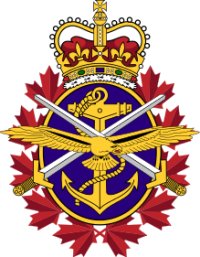 In a post from earlier this week about defence spending priorities for the Canadian military, Ted Campbell looks at how wars changed between the first half of the 20th century and the post-Cold War situation we face today:
In a post from earlier this week about defence spending priorities for the Canadian military, Ted Campbell looks at how wars changed between the first half of the 20th century and the post-Cold War situation we face today:
Is the 2% goal wrong?
No … it’s a pretty sensible level of defence spending for countries that really want to maintain a world at peace, as opposed to those, like Canada and many of its allies, that just want to hope for peace. But 2% is not a magic bullet … 1.5% of GDP, spent carefully, will do more than 2% spent as a job creation slush fund. But spending too little, cutting defence spending again and again and again just because it is unpopular can leave a country with what I have described as a Potemkin Village, a military that is more show than force.
The advent of a nuclear face-off circa 1950 changed the strategic calculus for the rest of the 20th century. We suddenly had the “come as you are war” which meant having regular, professional forces in being and not being able to rely upon time and space to give us time, as we had in past wars, to mobilize our reserves. We would do well, 101 years after the battle of Vimy Ridge, to recall that it, in April 1917, was the first time since war was declared (in the summer of 1914) that the full Canadian Corps, of four infantry divisions, was in battle as a corps ~ it took us over 30 months to get from a tiny standing army backed by small but eager reserves to a full corps composed of about 100,000 of the Canadians who served overseas during that war. We went to war again in the late summer of 1939 and it was not until the summer of 1943, over 40 months later, that we had a small corps, of only two divisions and an independent armoured brigade, in battle, in Italy. It takes a long time to mobilize and equip and train an army. The operational doctrine of the long and expensive cold war said that we could no longer have that time.
It is not clear that we must or even should still have small reserves and a relatively larger permanent force. Perhaps the time has come to re-examine the assumptions that underlie our force structure ideas. Maybe we need 150,000 uniformed people but, maybe, the split should be 50/50 or 75,000 full time and 75,000 part time sailors, soldiers and air force members. Maybe a country like Canada, with a population that will, in 2050, approach 40 million, should have a larger force: say 75,000 full time and even 150,000 part time military members … maybe our reserve force “regiments’ should have 500 or 750 soldiers and be required to “generate” a trained company (125 soldiers) rather than having only 150 soldiers and being hard pressed to “generate” a platoon of only 30 soldiers. I have my own ideas, but someone who has the necessary information at their disposal needs to look ahead at our strategic situation and develop a force model and a sane budget for 2050. That should be a job for skilled civil servants in the defence policy staff.
Our strategic priorities for the next 30 years or more need to be:
- Containing and reducing threats to global peace and security by helping to maintain alliances like NATO and groupings like AUSCANNZUKUS and supporting global peacemaking and peacekeeping efforts, even the generally worthless United Nations efforts;
- Confronting current threats to peace ~ like Russia ~ and deterring (by matching the growth in military power of) potential future threats ~ like China;
- Cooperating with the USA in the protection of North America; and
- Securing the land we claim as our own, the waters contiguous to it and the airspace over both.
When we work out the costs, of people, above all, but also of ships, tanks, guns and aircraft, and of ammunition, food and fuel and everything else, of doing those four things ~ and of doing them well enough ~ then we will know what what sort of forces we need and how much we must budget to build and maintain them. But no matter what the size and what the cost, I guarantee that people will still be the biggest single expense if we keep our priorities straight: and the overarching priority is that people cost more than machines because they matter more than machines.
March 25, 2018
Conscientious Objectors – Water – “Wastage” I OUT OF THE TRENCHES
The Great War
Published on 24 Mar 2018Chair of Wisdom Time!
November 11, 2017
Vimy Ridge Heaven to Hell – Full Documentary
Bobmarliist
Published on 8 Feb 2013
November 10, 2017
The Russian October Revolution 1917 I THE GREAT WAR Week 172
The Great War
Published on 9 Nov 2017After the turmoil of the past weeks in Petrograd, the Soviets and the Red Guards seize the opportunity and topple the provisional government under Alexander Kerensky. Their first goal is to pull out of the war. The Italians were still in full retreat during the Battle of Caporetto and the British Army was still advancing in Palestine.
November 6, 2017
The end of the battle of Passchendaele, 1917
The Canadian Corps under Lieutenant General Arthur Currie began the final phase of the battle on 6 November, 1917:
By 6 November, the Canadians were prepared to advance upon the Green Line. The final objective was to capture the high ground north of the town and to secure positions on the eastern side of Passchendaele Ridge. Again, according to Major Robert Massie: “The third attack … was the day when the First and Second Divisions took Passchendaele itself. On this occasion, the attack went off the most smoothly of any of the three. They had fair ground to go over, and especially those that went into Passchendaele itself had pretty fair going, and the objectives were reached on time.”
After early hand-to-hand fighting, the 2nd Division easily occupied Passchendaele just three hours after commencement of the attack at 0600 hours. The 1st Division, however, found itself in some trouble when one company of the 3rd Battalion became cut off and was stranded in a bog. When this situation eventually righted itself, the 1st Division continued toward its objectives. Well-camouflaged tunnels at Moseelmarkt provided an opportunity for the enemy to counterattack, but they were fended off by the Canadians. By the end of the day, the Canadian Corps was firmly in control of both Passchendaele and the ridge.
The final Canadian action at Passchendaele commenced at 0605 hours on 10 November 1917. Sir Arthur Currie used the opportunity to make adjustments to the line, strengthening his defensive positions. Robert Massie summed up the thoughts of many participating Canadians as follows: “What those men did at Passchendaele was beyond praise. There was no protection in that land. They could not get into the trenches which were full of mud, and you would see two or three of them huddled together during the night, lying on ground that was pure mud, without protection of any kind, and then going forward the next morning and cleaning up their job.”
The Canadians had done the impossible. After just 14 days of combat, they had driven the German army out of Passchendaele and off the ridge. There was almost nothing left of the village to hold. Altogether, the Canadian Corps had fired a total of 1,453,056 shells, containing 40,908 tons of high explosive. Aerial photography verified approximately one million shell holes in a one square mile area. The human cost was even greater. Casualties on the British side totalled over 310,000, including approximately 36,500 Australians and 3596 New Zealanders. German casualties totalled 260,000 troops.
For the Canadians, Currie’s words were prophetic. He had told Haig it would cost Canada 16,000 casualties to take Passchendaele – and, in truth, the final total was 15,654, many of whom were killed. One thousand Canadian bodies were never recovered, trapped forever in the mud of Flanders. Nine Canadians won the Victoria Cross during the battles for Passchendaele. While the human cost had been terrible: “Nevertheless, the competence, confidence, and maturity began in 1915 at Ypres a short distance away, and at Vimy Ridge earlier that spring, again confirmed the reputation of the Canadian Corps as the finest fighting formation on the Western Front.” So wrote esteemed Professor of History Doctor Ronald Haycock at the Royal Military College of Canada for The Oxford Companion to Canadian History in 2004.
Haig proved to be true to his word. By 14 November 1917, the Canadians had been returned to the relative quiet of the Vimy sector. They had not been asked to hold what it had cost them so much to take. However, by March 1918, all the gains made by Canada at Passchendaele would be lost in the German spring offensive known as Operation Michael.
General Sir David Watson praised the Canadian effort: “It need hardly be a matter of surprise that the Canadians by this time had the reputation of being the best shock troops in the Allied Armies. They had been pitted against the select guards and shock troops of Germany and the Canadian superiority was proven beyond question. They had the physique, the stamina, the initiative, the confidence between officers and men (so frequently of equal standing in civilian life) and happened to have the opportunity.”
British Prime Minister David Lloyd George was even clearer when it came to the Canadians: “Whenever the Germans found the Canadian Corps coming into the line they prepared for the worst.”
November 3, 2017
Battle of Beersheba – Canadian Frustration – Balfour Declaration I THE GREAT WAR Week 171
The Great War
Published on 2 Nov 2017On the Western Front this week, the Canadians under Sir Arthur Currie attempt to advance once more, whilst Haig remains optimistic about an imminent breakthrough. Following Caporetto, the Italian retreat continues, whilst the British Army enjoys success on the Palestine Front, with a little help from mounted ANZAC troops. With Lenin’s return, the revolution looms over the Russian capital, whilst the Balfour Declaration is issued in Britain.

